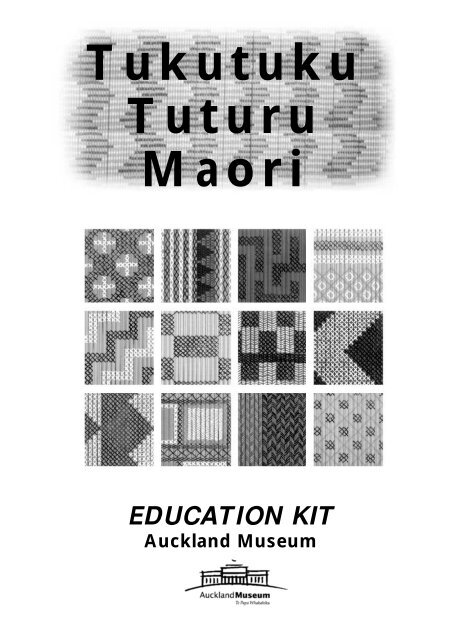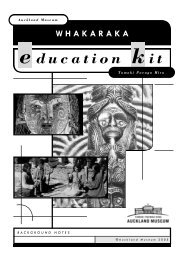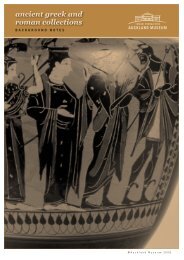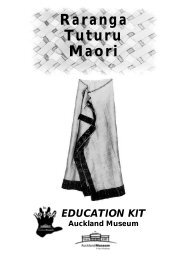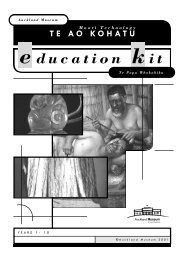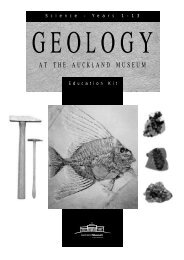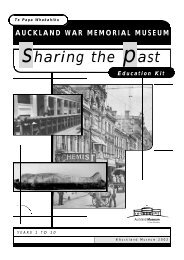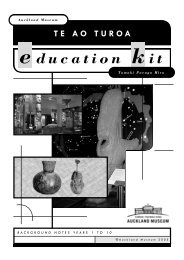Tukutuku Tuturu Maori - Auckland Museum
Tukutuku Tuturu Maori - Auckland Museum
Tukutuku Tuturu Maori - Auckland Museum
Create successful ePaper yourself
Turn your PDF publications into a flip-book with our unique Google optimized e-Paper software.
<strong>Tukutuku</strong><br />
<strong>Tuturu</strong><br />
<strong>Maori</strong><br />
EDUCATION KIT<br />
<strong>Auckland</strong> <strong>Museum</strong>
Introduction<br />
Index<br />
<strong>Tukutuku</strong><br />
<strong>Tuturu</strong><br />
<strong>Maori</strong><br />
Introduction 1<br />
Teacher Background Information 2<br />
Curriculum Links 8<br />
Pre-Visit Activities 15<br />
Post-Visit Activities 15<br />
Activity Sheets 16<br />
He Korero<br />
Whakatuwhera<br />
I waihangatia tenei rauemi mo te<br />
mahi tukutuku I te<br />
whakaaetanga o Te Manatu<br />
Matauranga kia riro mai tetahi<br />
kirimana I tenei roopu "Wheako<br />
Ako I Waho Atu I te Akomanga."<br />
He pai tenei rauemi ma nga<br />
Kura Kaupapa <strong>Maori</strong>,nga<br />
Whanau Reo Rua,nga Ruma<br />
Rumaki I te Reo me nga<br />
Kohanga-Reo <strong>Maori</strong>.<br />
Anei e whai ake nei nga whainga<br />
paetae tika mai te Anga<br />
Matauranga o Aotearoa.Ko nga<br />
wahanga kaupapa e hipokina<br />
atu, ko Te Reo <strong>Maori</strong>, te<br />
Pangarau me Te Reo Pakeha.<br />
Introduction<br />
This resource has been created<br />
as a result of the Ministry of<br />
Education contract for "Learning<br />
Experiences Outside the<br />
Classroom".<br />
This resource has been designed<br />
for Kura Kaupapa,Total<br />
Immersion,Bilingual and<br />
Kohanga Reo schooling<br />
initiatives.<br />
The resource incorporates<br />
appropriate achievement<br />
objectives from the National<br />
Curriculum Framework of New<br />
Zealand.<br />
The Curriculum Statements<br />
covered are Te Reo <strong>Maori</strong>,<br />
Pangarau, English and<br />
Mathematics (Levels 1-4).<br />
Acknowledgement<br />
Grateful thanks and appreciation for their help and advice in the<br />
compiling of this resource is made to Moana Rini and Peter Boy d.<br />
Ma t e At ua e manaaki,<br />
Ma tana tama,ko Ihu Karaiti e tiaki,<br />
Ma t e Wairua Tapu e Arahi.<br />
Tena Korua!<br />
© 1997 <strong>Auckland</strong> <strong>Museum</strong><br />
1
Teacher Background<br />
Information<br />
<strong>Tukutuku</strong> panels are<br />
synonymous w ith carvings and<br />
kowhaiwhai patterns when we<br />
think of Whare Whakairo-<br />
Wharenui. In most Meeting<br />
Houses one can look forward to<br />
admiring the tukutuku panels in<br />
between the poupou. The re, the<br />
interpretation of each tukutuku<br />
design w ill complement and<br />
reinforce the stories told in the<br />
carvings and kowhaiwhai<br />
patterns.<br />
Not only are tukutuku patterns<br />
an integral part of the<br />
storytelling of each Whare, they<br />
add aesthetic beauty to the<br />
interior of the House. In contrast<br />
to the spirals,sw irls and curved<br />
lines of the carvings and<br />
kowhaiwhai paint-work, the<br />
straight lines that form the basis<br />
of all tukutuku design provide a<br />
distinctive component in the<br />
overall art form of each House.<br />
In more recent times, tukutuku<br />
designs have become an<br />
exciting feature to be found in<br />
Wharekai, Churches and<br />
reception areas of business<br />
houses. New innovations reveal<br />
the clever adaptation of<br />
tukutuku to make fire-screens,<br />
glass covered table-tops and<br />
room dividers.<br />
Sedge<br />
(Pingao).<br />
Kiekie. The fruit shown above<br />
were know n as ureure.<br />
© 1997 <strong>Auckland</strong> <strong>Museum</strong><br />
<strong>Tukutuku</strong> Panel Structure:<br />
Traditional<br />
The traditional tukutuku panel is<br />
a lattice-like frame made up of<br />
vertical stakes which form the<br />
back layer of the frame (can NOT<br />
be seen); ho rizontal rods that<br />
form the layer of the panel (that<br />
can be seen by the viewer); and<br />
flexible material, being both<br />
pingao and kiekie which when<br />
threaded through the rods and<br />
stakes form the patterns and<br />
designs.<br />
Toetoe stalks w ere the kakaho<br />
(vert ical stakes). Stalks were<br />
arranged close together to form<br />
the single back layer. Flow er<br />
ends and butt ends were laid<br />
alternately to maintain an even<br />
width.<br />
Wooden slats (horizontal rods),<br />
coloured with wood-stain or<br />
paint, were placed close<br />
together. These completely<br />
covered the kakaho, forming the<br />
exposed layer on which the<br />
pattern would be viewed.<br />
The leaves of the kiekie, (an<br />
epiphyte; a perching plant found<br />
growing in the branches of<br />
trees) were gathered and<br />
bleached to be used for the<br />
colour white in the patterns.<br />
Bleaching meant that the leaves<br />
were stripped, boiled and hung<br />
out to dry in the sun and w ind.<br />
Strips were also dyed when the<br />
pattern required the addition of<br />
colours.<br />
Kiekie flowers. Known to<br />
<strong>Maori</strong> as tawhare.<br />
2
Background<br />
Information<br />
Pingao (a coastal plant growing<br />
on sandhills) w as used for its<br />
rich gold/orange colour.<br />
Preparation meant that pingao<br />
was gathered and sized into<br />
lengths, then hung out in a<br />
shady spot. Stripping was done<br />
on the frame.<br />
Detail of assembly of tukutuku.<br />
Mo dern Inno vat io ns<br />
in the Making<br />
Substitutes for traditional<br />
materials have become widely<br />
accepted, as they are readily<br />
available all year round and are<br />
more versatile.<br />
An excellent replacement for the<br />
lattice-like frame structure is<br />
peg-board, which can be<br />
purchased in a range of sizes<br />
and then cut into different<br />
shapes.<br />
Dyed raffia and fibre plastic<br />
strips are often used instead of<br />
kiekie and pingao. These<br />
materials are available in vibrant<br />
colours, some fluorescent and<br />
w hen used, w ill produce an<br />
exciting effect. These materials<br />
are also preferred as they have a<br />
longer life than traditional<br />
materials and do not require<br />
regula r maintenance.<br />
Design interpretations are taken from:<br />
*Pownell,Glen: N ew Zealand <strong>Maori</strong> Arts And Crafts 1976<br />
**"Marae":Volume 1:Number 2:1974.<br />
© 1997 <strong>Auckland</strong> <strong>Museum</strong><br />
Alternative materials for the<br />
vertical stakes and horizontal<br />
rods are half-round w ooden<br />
slats,dowels, bamboo and stalks<br />
of the South American pampas<br />
grass.<br />
Illustrations<br />
Ro imat a To ro a o r Ro imat a<br />
Turut uru: Albatross Tears<br />
The albatross is a rare and<br />
wonderful visitor to the northern<br />
parts of New Zealand and was<br />
revered by the pre-European<br />
<strong>Maori</strong>. The tears of the albatross<br />
signified something that was<br />
both rare and beautiful and as<br />
such w as incorporated into<br />
tukutuku work.*<br />
The story attached to this design<br />
tells of the introduction of the<br />
kumara plant, a story ending in<br />
misadventure and lamentation.<br />
Pourangahau (Pourangahua ) was<br />
one of the chief scientists sent<br />
from Haw aiki to report on the<br />
climatic and geographical<br />
conditions of Aotearoa soon<br />
after Kupe's voyage of<br />
discovery. Accompanied by his<br />
w ife, Kaniowai, and others, he<br />
3
surveyed his given area of<br />
Gisborne and the East Coast and<br />
calculated by the growth of<br />
vegetation that spring was<br />
imminent. He returned in haste<br />
to Hawaiki, there to report to his<br />
chief Ruakapanga, who urged<br />
his immediate return with the<br />
kumara tipu (kumara shoots) to<br />
Aotearoa lest he be too late for<br />
the planting season.<br />
To aid him, Ruakapanga gave<br />
him the loan of his tw o giant<br />
birds, Harongarangi and<br />
Tiungarangi, to take him there<br />
swiftly: at the same time he gave<br />
Pou strict instructions as to his<br />
route, the incantations that were<br />
necessary and the care that<br />
must be lavished on the birds.<br />
When he bid him farewell, he<br />
entrusted to him Mamainuku<br />
and Mamairangi, his two sacred<br />
ko (digging implements). Exalted<br />
by this honour - the first<br />
recorded trans-Pacific air<br />
crossing - and thrilled by the<br />
comfort and speed of his flight<br />
Pou forgot all thought of the<br />
instructions and incantations<br />
and prayers. Despite all this, he<br />
was carried safely and sw iftly to<br />
his destination.<br />
However, on arrival he neglected<br />
the birds shamefully. When, too<br />
late, he remembered his<br />
instructions he found the birds<br />
outside his house w eeping tears<br />
of w eariness and sorrow .Where<br />
they had been fondled and<br />
petted by their master<br />
Ruakapanga, they were now<br />
abused and neglected by Pou.<br />
His attempt to make amends<br />
being unsuccessful, he sent<br />
them off on their homeward<br />
journey.<br />
On their way they were beset by<br />
Tunui-o-te-Ika and other<br />
evildoers so that when they<br />
eventually arrived home, their<br />
physical condition revealed the<br />
whole sorry tale of neglect to<br />
Rua.<br />
© 1997 <strong>Auckland</strong> <strong>Museum</strong><br />
For this crime of Pou's and for<br />
the tears that Harongarangi and<br />
Tiungarangi had shed, he<br />
caused the pests anuhe<br />
(caterpillar), mokoroa (a large<br />
white grub) and mokow hite to<br />
attack the kumara. To this day<br />
the kumara plant is still ravaged<br />
by these pests every year.<br />
Thus it is the roimata (tears)<br />
pattern - memorial to the tears<br />
of the toroa (albatross) weeping<br />
for their loved one, that we<br />
select when we wish to depict<br />
disaster in war, death or<br />
catastrophe.**<br />
Po ut ama: The Stairway To<br />
Heaven<br />
The Poutama design in ancient<br />
lore symbolised a climb made by<br />
a folk hero Tawhaki to receive<br />
the three baskets of knowledge<br />
from the gods.*<br />
The <strong>Maori</strong> interpretation of the<br />
word is "one who supports his<br />
family sub-tribe and tribe", in a<br />
word, chief or rangatira. When<br />
we look at the construction of<br />
poutama, we find a series of<br />
steps denoting the steps of<br />
progress and advance. Briefly,<br />
these are education and the<br />
striving for betterment, the<br />
planning of a child's future… by<br />
parents, family and tribe - the<br />
ultimate mark of a born leader.<br />
**<br />
4
Background<br />
Information<br />
Pat ikitiki: Flounder. Also the<br />
<strong>Maori</strong> name for group of stars<br />
near t he Milky way- t he "Co al-<br />
Sack"<br />
The flounder is a fairly common<br />
flat fish found near the beaches<br />
and estuaries on the New<br />
Zealand coast. Of distinctive<br />
diamond shape and delicious<br />
flavour, this fish is a favourite<br />
food of New Zealanders ‘in the<br />
know ’.*<br />
The constellation forms a<br />
diamond shape and the experts<br />
of old had it that they sw ing in<br />
their position near the Milky<br />
Way, according to the weather.<br />
When the diamond lies parallel<br />
to the Milky Way, expect fine<br />
weather,when the diamond<br />
points away from the Milky Way,<br />
prepare for a spell of bad<br />
weather. This w as a convenient<br />
way of forecasting the weather<br />
in the old days when the <strong>Maori</strong><br />
lived on the sea-coast,<br />
subsisting mainly on sea-foods.<br />
When the indications by the<br />
stars w ere favourable, great<br />
harvests were the order of the<br />
day as the flounder came in to<br />
the shallow waters. Similarly,<br />
other sea-foods were taken in<br />
abundance. The design signified<br />
good weather, abundance of<br />
food and well-fed families.**<br />
© 1997 <strong>Auckland</strong> <strong>Museum</strong><br />
Purapura Whetu: Purapuramyriads;<br />
whetu-stars<br />
A poetic expression for the<br />
multitude of stars seen in the<br />
heavens at night…. the <strong>Maori</strong><br />
desire for a large family is a trait<br />
handed dow n from our<br />
ancestors. Generally speaking, a<br />
man w ho visualises big things<br />
usually has a large family; the<br />
head of a small family is often<br />
more prone to think and plan in<br />
a narrow er, more circumscribed<br />
manner. The pattern is striking,<br />
especially when encountered<br />
among more elaborate panels,<br />
for its simplicity and strength.<br />
One building only in the w hole<br />
of New Zealand had this pattern<br />
exclusively and that is the<br />
Rangiatea Church at Otaki [sadly<br />
lost to fire]. The sentiment<br />
depicted therein is that the<br />
Church may acquire members of<br />
the Christian faith "as many as<br />
the stars in number."**<br />
5
Nihotaniwha: The Teet h of the<br />
Dragon<br />
Taniwha are mythical monsters<br />
usually associated with the<br />
ocean, lakes and rivers of New<br />
Zealand. Feared for the<br />
destruction they wrought, their<br />
sharp diamond pointed teeth are<br />
symbolised by this design.*<br />
The persistency of the "taniwha"<br />
stories throughout <strong>Maori</strong>dom is<br />
now decreasing, but try to<br />
picture the scene of old. The<br />
dying embers in the<br />
Meetinghouse at night, the<br />
how ling w ind and the pelting<br />
rain--these were the atmosphere<br />
for such stories, and the lively<br />
mind of the listener filled in the<br />
gaps. The slaughter by the dread<br />
monster, the trembling and<br />
fearful planning for revenge, the<br />
luring of the taniw ha, the<br />
baiting, the attack, the kill - and<br />
suddenly the heavens w ithout<br />
are rent by jagged lightening<br />
and thunder!**<br />
Kao kao: Human Ribs-Armpits<br />
© 1997 <strong>Auckland</strong> <strong>Museum</strong><br />
Abstraction and symbolism, to<br />
the point where the human<br />
element is difficult to recognise,<br />
represents the interfusion of the<br />
spiritual and temporal life of the<br />
<strong>Maori</strong>.*<br />
This pattern was dedicated to<br />
the war-god, Tumatauenga. By<br />
placing the pattern upside down,<br />
we obtain the (military) chevron,<br />
signifying promotion in rank<br />
(the kaokao sentiment of<br />
"discernment, decision and<br />
design"). Prior to setting out on<br />
a war expedition, all the warriors<br />
were made to step on a takapau<br />
(mat) with the kaokao pattern,to<br />
inspire them. The open armpit<br />
distinguishes the warrior<br />
(signif ying a raised arm ready<br />
for battle). The closed armpit,<br />
the weak and frightened one<br />
huddled in fear.**<br />
Waamu or Mumu and<br />
Whanganui Mumu<br />
Almost a draught-board effect of<br />
patterns arranged to produce a<br />
diagonal sequence and<br />
(sometimes) used with purapura<br />
whetu,kaokao,poutama,<br />
roimata… designs. A mumu<br />
gives a lightening and pleasing<br />
effect to an otherw ise<br />
dark recess. The<br />
Whanganui people<br />
brought out the<br />
mumu to advantage<br />
by dividing the panel<br />
into three equal<br />
vertical sections, and<br />
by the judicious<br />
employment of the<br />
above patterns,made<br />
a great contribution<br />
to interior<br />
decoration. Their<br />
meeting house at<br />
Putiki, Te<br />
Pakuoterangi, is a<br />
striking w itness to<br />
this. Its significance<br />
is that of<br />
combination; applied<br />
inter-tribally, it<br />
denotes intermarriage<br />
between<br />
senior families.**<br />
6
Background<br />
Information<br />
Tumat akahuki: To bind in<br />
double or triple fashion<br />
This double or triple binding<br />
ensures extra strength and the<br />
accurate alignment of all<br />
materials horizontally, vertically,<br />
and diagonally.The<br />
tumatakahuki forms a decorative<br />
pattern along the outside edges<br />
and other divisions of a panel. In<br />
the days when all materials were<br />
fashioned by hand, the square<br />
and uniform level of the work<br />
depended upon a firm secure<br />
method of binding.**<br />
Te Hono A Matuku-<br />
Tangotango:<br />
When the end of a strand of<br />
kiekie has been reached, the<br />
new piece is attached by tying it<br />
to the end of the first strand at<br />
the back of the panel. The hono<br />
(a tying) of matuku-tangotango<br />
is employed.A slip-knot is<br />
fashioned in the new piece. This<br />
is slipped over the end of the<br />
old short piece, pulled tight<br />
against it and then tied. This has<br />
the effect of turning the joined<br />
piece back again so that the<br />
work is ready to proceed w ithout<br />
apparent break.**<br />
Bibliography<br />
• <strong>Auckland</strong> University Marae<br />
Booklet, page 23-29.<br />
• Hamilton, Augustus; <strong>Maori</strong><br />
Art: The New Zealand Institute<br />
(Wellington,1896)<br />
• Neich, Roger; Pa inted<br />
Histories: Early <strong>Maori</strong><br />
Figurative Paint ing (<strong>Auckland</strong><br />
University Press,1993)<br />
• Pow nall,Glen; New Zealand<br />
<strong>Maori</strong> Arts And Crafts<br />
(Sevenseas Publishing,1976)<br />
page 90-101.<br />
• Retimana, Mihiata; <strong>Tukutuku</strong><br />
and Kowhaiwhai (History<br />
Guide) (Government<br />
Printer,1972)<br />
• Taiapa, Pine; “<strong>Tukutuku</strong>”<br />
Marae: Volume 1, Number 2,<br />
(1974) page 3-9.<br />
Glossary<br />
kowhaiwhai<br />
scroll patterns often,<br />
alt hough not always,<br />
painted on t he ceiling<br />
rafters of a Meeting House<br />
poupou<br />
upright carved slabs<br />
forming wall structure<br />
inside Meeting House<br />
wharekai<br />
dining hall(s)<br />
whare whakairo/<br />
wharenui/whare<br />
Traditional <strong>Maori</strong> (Carved)<br />
Meeting House(s)<br />
7
Curriculum Links<br />
Te Anga Marautana O<br />
Aotearoa<br />
The New Zealand<br />
Curriculum Framework<br />
Te Reo <strong>Maori</strong><br />
WHENU: Matakitaki<br />
(Whakaatu)<br />
Koeke 1<br />
Whainga Paetae<br />
Ka mau te akonga ko te tikanga<br />
o te reo ataata he w hakaw hiti<br />
korero.<br />
Nga Pukenga<br />
ko te tautu I nga tumomo reo-awaha<br />
e hangai ana ki te reo<br />
ataata<br />
Aro Matawai<br />
Ka whakaaturia tana<br />
tohungatanga ki te<br />
• tautu I te panga atu o te reo-awaha<br />
ki nga tohu ataata;<br />
• tautu I nga tohu a te <strong>Maori</strong><br />
penei I te niho taniw ha,te<br />
poutama;<br />
• whakautu tika nga tohu<br />
mama.<br />
Koeke 2<br />
Whainga Paetae<br />
Ka marama te akonga ki te<br />
hononga o te reo ataata ki te<br />
reo-a-waha, mehemea ka puta<br />
ake I nga horpaki e taunga ana<br />
ia.<br />
Nga Pukenga<br />
ko te tautu I nga mohiotanga e<br />
tika ana kia mau e te akonga<br />
mai I nga reo ataata e<br />
whakaaturia ana ki te taha o te<br />
reo a waha<br />
Aro Matawai<br />
Ka whakaaturia tana<br />
tohungatanga ki te:<br />
• whakamarama I te ahuatanga<br />
o te reo ataata;<br />
• whakaputa reo-a-waha e<br />
hangai ana ki te ahua o te reo<br />
ataata<br />
© 1997 <strong>Auckland</strong> <strong>Museum</strong><br />
Koeke 3<br />
Whainga Paetae<br />
Ka matakitaki, ka marama te<br />
akonga ki nga momo reo ataata,<br />
reo-a-waha, me te mohio ano ki<br />
te panga o tetahi ki tetahi.<br />
Nga Pukenga<br />
ko te auahatanga o te whakaaro<br />
reo ataata<br />
Aro Matawai<br />
Ka whakaaturia tana<br />
tohungatanga ki te:<br />
• whakamarama I nga<br />
ahuatanga whai kiko, kaore<br />
ranei e w hai kiko, o te noho<br />
tahi a te reo-a-waha me te reo<br />
ataata.<br />
Koeke 4<br />
Whainga Paetae<br />
Ka ahei te akonga ki te<br />
whakamarama I te ahua o nga<br />
panga o te reo ataata poto I<br />
takea mai I nga horopaki kaore<br />
ia e tino taunga ana.<br />
Nga Pukenga<br />
ko te whakatauriterite I nga<br />
mahinga reo ataata<br />
Aro Matawai<br />
Ka whakaaturia tana<br />
tohungatanga ki te:<br />
• whakatau I te whainga o tetahi<br />
mahinga reo ataata.<br />
WHENU:Whakaatu<br />
(Matakitaki)<br />
Kooeke 1<br />
Whainga Paetae<br />
Ka taea e te akonga te<br />
whakaputa whakaaro (e pa ana<br />
ki ona hiahia I roto I tona ao ) ki<br />
te reo-a-tinana me nga reo<br />
ataata.<br />
Nga Pukenga<br />
• ko te whakapuaki whakaaro ki<br />
te reo ataata<br />
• ko te tuhi reo ataata mama<br />
hei w hakaw hiti mohio<br />
Aro Matawai<br />
Ka whakaaturia tana<br />
tohungatanga ki te:<br />
• tuhi,ki te hanga I nga tohu<br />
ataata e hangai ana ki te reo -<br />
a-waha<br />
• whakaatu I nga tohu <strong>Maori</strong><br />
8
Curriculum<br />
Links<br />
Koeke 2<br />
Whainga Paetae<br />
Ka taea e te akonga te<br />
whakaputa reo-a-waha, reo<br />
ataata hoki e pa ana ki nga<br />
kaupapa e taunga ana ia.<br />
Nga Pukenga<br />
• ko te matau ki nga<br />
re reketanga o te reo ataata I<br />
te reo-a-waha<br />
• ko te tautu I te putake o te reo<br />
ataata<br />
• ko te hanga I nga ataata<br />
whakaniko I te reo-a-waha.<br />
Aro Matawai<br />
Ka whakaaturia tana<br />
tohuhangatanga ki te:<br />
• w hakaw hiti mohio ki te reo<br />
ataata<br />
• whakamahi I nga ahuatanga<br />
reo ataata hei whakaniko I te<br />
reo-a-waha<br />
• whakaatu I nga whakaaro ki te<br />
reo ataata<br />
Koeke 3<br />
Whainga Paetae<br />
Ka taea e te akonga te<br />
whakamahi ngatahi te reo-awaha<br />
me te reo ataata kia puta<br />
ai nga panga e hiahiatia ana.<br />
Nga Pukenga<br />
• ko te tautu I nga panga o<br />
etahi ahuatanga reo ataata<br />
• ko te whakakotahi I te reo<br />
ataata me te reo-a-waha<br />
• ko te tipako I te ahuatanga<br />
reo ataata e hangai ana ki te<br />
reo-a-waha<br />
• ko te whakamahi I tetahi<br />
ahuatanga reo ataata e whai<br />
hua ai te korero.<br />
Aro Matawai<br />
Ka whakaaturia tana<br />
tohungatanga ki te:<br />
• whakamahi I nga ahuatanga<br />
reo ataata mama<br />
• w hakataurite i nga hua o nga<br />
ahuatanga reo ataata<br />
© 1997 <strong>Auckland</strong> <strong>Museum</strong><br />
• whakamahi ngatahi I te reo<br />
ataata me te reo-a-waha kia<br />
w hai hua ai te korero.<br />
Koeke 4<br />
Whainga Paetae<br />
Ka whakaatu te akonga I te reo<br />
ataata I nga horopaki huhua , a, e<br />
hangai ana te whakaaturanga ki<br />
te kaimatakitaki<br />
Nga Pukenga<br />
• ko te tipako I nga ahuatanga<br />
reo ataata e hangai ana ki te<br />
horopaki<br />
• ko te tautu I te hangai o nga<br />
ahuatanga reo ataata ki te<br />
horopaki<br />
Aro Matawai<br />
Ka whakaaturia tana<br />
tohungatanga ki te:<br />
• whakaatu reo ataata kia whai<br />
hua ai ki te hunga matakitaki<br />
<strong>Maori</strong>.<br />
PANGARAU<br />
Te Ahuahanga<br />
Taumata 1<br />
Whainga Paetae<br />
Te torotoro hangarite, panoni<br />
I roto I nga horopaki w hai<br />
tikanga, me mohio te akonga:<br />
• ki te hanga, ki te whakaahua I<br />
nga tauira hangarite, tauira<br />
taruarua.<br />
He Tauira Horopaki<br />
• He ata tirotiro I nga tauira<br />
tukutuku<br />
He Tauira Mahi<br />
• he hanga, he matapaki ahua e<br />
w hai wahi mai ana he panoni<br />
(w hakaatanga, huriha nga,<br />
nekehanga, whakarahinga )<br />
• he w hiriw hiri, he hanga tauira<br />
hangarite<br />
Aro Matawai<br />
• He hanga tauira ki te riw ai, ki<br />
te hopi, ki te kahupeka, ki te<br />
ukupoke ranei, ka mahi mai ai<br />
I etahi tauira taruarua,<br />
hangarite ranei.<br />
9
Taumata 2<br />
Whainga Paetae<br />
Te torotoro hangarite, panoni<br />
I roto I nga horopaki w hai<br />
tikanga, me mohio te akonga:<br />
• ki te hanga, ki te whakaahua<br />
tauira ahuahanga taruarua (ka<br />
w hakaatu I te nekehanga),<br />
tauira hangarite huri,<br />
hangarite whakaata ke ranei<br />
He Tauira Horopaki<br />
• He torotoro, he matapaki<br />
tauira hangarite, w hakaata<br />
ranei I roto I nga tukutuku.<br />
He Tauira Mahi<br />
• he ata tirotiro I nga tauira I<br />
roto I nga tukutuku. Me ata<br />
mahi mai e nga akonga tetahi<br />
papa tukutuku hei whakairi<br />
ma ratou ki roto I te<br />
taiw hanga ako.<br />
• he torotoro whakarahinga<br />
mama ,mai I tetahi tauira<br />
tukutuku. Hei whakatauira:<br />
Aro Matawai<br />
He mahi mai I tetahi tauira<br />
tukutuku.Ahakoa he aha te<br />
momo, ko te mea nui ke kia<br />
hangarite te ahua, a, kia tika nga<br />
inenga.<br />
Taumata 3<br />
Whainga Paetae<br />
Te torotoro hangarite, panoni<br />
I roto I nga horopaki w hai<br />
tikanga, me mohio te akonga:<br />
© 1997 <strong>Auckland</strong> <strong>Museum</strong><br />
• ki te w hakaahua tauira I runga<br />
ano I te ahua o te panoni, ara,<br />
he w hakaatanga, he hangarite<br />
hurihuri, he nekehanga ke<br />
ranei<br />
• ki te hoahoa, ki te mahi mai I<br />
tetahi tauira e w hai wahi mai<br />
ana te nekehanga whakaata,<br />
te hurihanga ranei<br />
• ki te w hakanui I nga ahua<br />
mama ki te pepa tukutuku, kia<br />
hangai ai te rahinga ake ki<br />
tera kua whakaritea.<br />
He Tauira Horopaki<br />
• Hei whakatauira, titiro ki te<br />
w henua, ki nga aw a, ki nga<br />
pae maunga, ki nga pa<br />
kainga, nga Marae, nga wahi<br />
tapu o mua.<br />
He Tauira Mahi<br />
• Me mohio te akonga ki te<br />
w hakaahua tauira I runga ano<br />
I te ahua o te panoni, ara , he<br />
w hakaatanga, he hangarite<br />
hurihuri, he nekehanga ke<br />
ranei<br />
(1)he whakamahi kupu e tika ana<br />
mo nga panoni, ara ko nga kupu<br />
penei I enei:<br />
hangarite… rara ngi… huri…<br />
rite….. nekehanga… Puma u…<br />
whakatitaha… poupou…<br />
whakahuapae<br />
(2)he hoahoa tauira e w hai wahi<br />
mai ana he nekehanga, he<br />
w hakaatanga, he hurihanga<br />
ranei. Ko te wharenui tonu tetahi<br />
wahi pai hei torotoro i enei<br />
momo panoni- kei nga<br />
kowhaiwhai, nga whakairo me<br />
nga tukutuku etahi tauira o enei<br />
panoni e mau ana .)<br />
• Me mohio te akonga ki te<br />
hoahoa, ki te mahi mai I tetahi<br />
tauira e whai wahi mai ana te<br />
neketanga, te whakaatanga, te<br />
huritanga ranei<br />
• Me mohio te akonga ki te<br />
w hakaw hanui I nga ahua<br />
mama ki te pepa tukutuku, kia<br />
hangai ai te rahinga ake ki<br />
tera kua whakaritea;<br />
(1)he w hakanui I te ahua o tetahi<br />
tauira kua ata whakaritea hei<br />
w hiriw hiri ma te akonga<br />
10
Curriculum<br />
Links<br />
(2)he whakaiti I te ahua o tetahi<br />
tauira kua ata whakaritea hei<br />
w hiriw hiri ma te akonga<br />
Aro Matawai<br />
Ko te marae.Me ata whiriwhiri-aropu<br />
nga ahuatanga hangarite o<br />
roto I te w harenui.<br />
(1)Ma ia akonga e whakaatu, e<br />
whakamarama tetahi tauira ki<br />
tana ropu<br />
(2)Ka mahi takirua nga akonga.<br />
Ka ata tuhi te akonga I tetahi<br />
haurua noa iho o tetahi tauira<br />
kua kitea e ia.Ko ta tana hoa,he<br />
w hakaoti I taua tauira i runga<br />
ano I te ahua o nga<br />
whakamarama mai a te akonga<br />
nana I timata te w hakaahua.Me<br />
whakaatu e te kaituhi mehemea<br />
he w hakaatanga,he hurihanga,he<br />
nekehanga ranei te panoni e<br />
hiahiatia ana hei whakaoti tika I<br />
tana tauira haurua .<br />
Taumata 4<br />
Whainga Paetae<br />
Te torotoro hangarite, panoni<br />
I roto I nga horopaki w hai<br />
tikanga, me mohio te akonga:<br />
• ki te w hakaahua I te hangarite<br />
whakaata, I te hangarite<br />
hurihuri ranei o tetahi ahua,<br />
taonga rane<br />
• He Tauira Horopaki<br />
• TE MAHI WHAI-Hei<br />
whakatauira, me pehea te<br />
hanga I te…(he w hakaaro e pa<br />
ana ki te hapu, ki te iw i, ki te<br />
rohe ranei)<br />
•<br />
© 1997 <strong>Auckland</strong> <strong>Museum</strong><br />
He Tauira Mahi<br />
Me mohio te akonga ki te<br />
whakanui, ki te whaiti ranei I<br />
tetahi ahu-2, ka tautuhi ai I nga<br />
ahuatanga pumau;<br />
• he torotoro I nga ahuatanga o<br />
tenei mea, o te<br />
whakapekatanga me te<br />
whakamahi ano I nga mahi<br />
tukutuku e tika ana<br />
Aro Matawai<br />
He hoahoa:<br />
korow ai, w hariki ra nei he<br />
tapaw ha, he tapatoru rane i kei<br />
roto (me hanga ki te taputapu<br />
tuhi ahua )<br />
English in the New Zealand<br />
Curriculum<br />
Level 1 - 2<br />
Visual Language: Viewing<br />
Reading visual… texts…<br />
students should:<br />
• respond to meanings and<br />
ideas …identifying and<br />
describing the…visual<br />
features<br />
In achieving the objectives of<br />
understanding and using visual<br />
language, students should:<br />
• understand that<br />
communication involves<br />
verbal and physical features<br />
which have co nvent io nally<br />
accepted meaning<br />
Teaching and Learning<br />
Context: a study of <strong>Tukutuku</strong><br />
patterns<br />
• The class visits the Aucklnd<br />
<strong>Museum</strong>, and students<br />
observe and discuss the<br />
tukutuku panels.<br />
• The class makes a collection<br />
of illustrations and<br />
photographs of tukutuku<br />
panels for a wall display.<br />
• The class discusses the ways<br />
tukutuku are presented and<br />
how they convey their<br />
meanings.<br />
• During discussion the teacher<br />
introduces concepts and<br />
terms such as Poutama, Patiki,<br />
Niho Taniwha, Roimata Toroa.<br />
11
Assessment<br />
The teacher notes the extent to<br />
w hich the students understand<br />
the meanings of the <strong>Tukutuku</strong><br />
patterns they have explored in<br />
the course of the study.<br />
Visual language: Presenting<br />
Using static… images, students<br />
should:<br />
• present ideas using simple<br />
<strong>Tukutuku</strong> designs<br />
• use verbal and visual features<br />
to communicate ideas or<br />
stories using <strong>Tukutuku</strong><br />
patterns.<br />
Teaching and Learning<br />
Context: exploring the<br />
interrelationship between<br />
dramatic, verbal, and visual<br />
features<br />
• The teacher and students<br />
collaborate in writing a story<br />
from a shared ex perience.<br />
• The teacher and students<br />
select t he main features of<br />
their story that can be<br />
portrayed in s imple tukutuku<br />
design.<br />
• Individually or in small<br />
groups, students choose one<br />
of the main features, and<br />
using peg-board and raffia,<br />
create a tukutuku design to<br />
reflect their choice.<br />
• Captio ns are written for eac h<br />
design.<br />
• Students arrange t heir work<br />
in sequence to build a class<br />
storyboard display.<br />
• The teacher and students<br />
discuss how the story<br />
sequence is illustrated in<br />
tukutuku patterns.<br />
Assessment<br />
• The teacher assesses the<br />
students' ability to retell t he<br />
story and choose suitable<br />
images.<br />
• The teacher observes the<br />
students during t he activit y<br />
and notes their participation,<br />
awareness, and<br />
understanding of how words<br />
and images relate to one<br />
another.<br />
© 1997 <strong>Auckland</strong> <strong>Museum</strong><br />
Levels 1 - 2<br />
Visual Language: Presenting<br />
Using static images…students<br />
should:<br />
• use verbal and visual features<br />
to communicate information,<br />
ideas or narrative t hrough<br />
tukutuku pattern<br />
• combine verbal and visual<br />
features to communicate<br />
information, ideas or<br />
narrative through tukutuku<br />
pattern`<br />
Teaching and Learning<br />
Context: a topic related to the<br />
locality<br />
• Students ex amine a range of<br />
tukutuku patterns, and note<br />
features of language and<br />
presentation, such as layout<br />
and design.<br />
• Each group of students is set<br />
the task of producing a group<br />
design to promote some<br />
significant feature of their<br />
locality to visitors.<br />
• Students gather, collate, and<br />
assemble the necessary<br />
information ready for<br />
developing their presentation.<br />
• The groups prepare t heir<br />
draft designs and discuss<br />
them with their peers for<br />
respo ns e in terms of<br />
suitability of the design and<br />
accuracy of informatio n.<br />
Draft patterns are revised.<br />
• Students create their designs<br />
and display them.<br />
Assessment<br />
• The teacher and students<br />
ex amine the designs and<br />
assess them for effectiveness,<br />
coherence of organisation,<br />
layout, and suitability for t he<br />
purpose.<br />
• The teacher observes<br />
students' participation in t he<br />
process and t heir<br />
understanding of the effects<br />
of visual language.<br />
Levels 3 - 4<br />
Visual Language: Viewing<br />
Reading visual… texts…<br />
12
Curriculum<br />
Links<br />
students should:<br />
• respond to and discuss<br />
meanings and ideas,<br />
ident ifying and describing t he<br />
effects of and links between<br />
verbal and visual features<br />
• respond to and discuss<br />
meanings, ideas,and effects,<br />
identifying the purposes for<br />
which t he verbal and visual<br />
features are used and<br />
combined<br />
In achieving the objectives of<br />
understanding and using visual<br />
language, students should:<br />
• identify and discuss ways in<br />
which verbal and visual<br />
features can be combined for<br />
a particular purpose and<br />
audience<br />
Teaching and Learning<br />
Context: a study of <strong>Tukutuku</strong><br />
patterns<br />
• The class view a selection of<br />
<strong>Tukutuku</strong> designs.<br />
• Students listen to explanations<br />
and stories associated with<br />
each design and note new<br />
vocabulary.<br />
• Students discuss how these<br />
ideas and stories are<br />
conveyed t hrough design form<br />
and colour.<br />
• In groups, students select a<br />
Topic and/or Theme, and<br />
work together to produce a<br />
tukutuku pattern that will be<br />
presented to the class,<br />
showing the ways in which<br />
they have combined t he visual<br />
and verbal elements to<br />
portray t heir Topic/ Theme.<br />
Assessment<br />
• Group presentat ions are<br />
assessed for evidence that<br />
important verbal and nonverbal<br />
features have been<br />
ident ified and ex plained.<br />
© 1997 <strong>Auckland</strong> <strong>Museum</strong><br />
Mathematics in the New<br />
Zealand Curriculum<br />
Geomet ry<br />
Level 1<br />
Achievement Objectives<br />
Exploring shape and space:<br />
Within a range of meaningful<br />
contexts the students should be<br />
able to;<br />
• ident ify, and describe in t heir<br />
own language, t he following<br />
2-dimensional and 3dimensional<br />
shapes: triangle,<br />
square, oblong, pentagon,<br />
hex agon, diamond…<br />
Exploring symmetry and<br />
transformations:Within a range<br />
of meaningful contexts,<br />
students should be able to;<br />
• create and talk about<br />
symmet rical and repeating<br />
patterns<br />
Learning Experience:<br />
Exploring symmetry and<br />
transformations; Students<br />
should be:<br />
• designing and talking about<br />
tukutuku patterns<br />
• ex ploring ways of fitting<br />
shapes toget her to cover<br />
surfaces(tessellations)<br />
• Finding within tukutuku<br />
patterns and then talking<br />
about pairs of objects, where<br />
one is an enlargement of the<br />
other.<br />
Assessment<br />
While students are sitting back<br />
to back in pairs;<br />
• using mosaic shapes, one<br />
part ner creates a simple<br />
tukutuku pattern and<br />
describes it. The part ner<br />
makes the model pattern<br />
based on t he instructions<br />
given.<br />
Level 2<br />
Achievement Objectives<br />
Exploring symmetry and<br />
transformations: Within a range<br />
of meaningful contexts,<br />
students should be able to;<br />
create and talk about geometric<br />
patterns which repeat, or which<br />
have rotational or reflection<br />
symmet ry<br />
13
Learning Experiences<br />
Exploring symmetry and<br />
transformations: Students<br />
should be;<br />
• ex ploring and creat ing<br />
tukutuku patterns involving<br />
translation, reflection, and<br />
rotational symmetry using a<br />
variety of manipulative<br />
equipment/materials.<br />
Assessment<br />
• Students use t he language of<br />
geometry to describe t he<br />
distinguishing features of<br />
tukutuku patterns they have<br />
made;<br />
• identify shapes that have both<br />
rotational and reflectional<br />
symmet ry<br />
• ident ify symmetry in shapes<br />
they make while playing whai<br />
(string games)<br />
Level 3<br />
Achievement Objectives<br />
Exploring symmetry and<br />
transformations:Within a range<br />
of meaningful contexts,<br />
students should be able to;<br />
• describe patterns in terms of<br />
reflection and rotational<br />
symmetry, and translations;<br />
• design and make a pattern<br />
which involves translat ion,<br />
reflection, or rotation;<br />
• enlarge on grid paper simple<br />
shapes to a specified scale.<br />
Learning Experieces<br />
Exploring symmetry and<br />
transformations: Students<br />
should be;<br />
• designing tukutuku patterns<br />
which involve translation,<br />
reflection, or rotation ;<br />
• showing the enlarging or<br />
reducing of shapes to a<br />
specified scale wit hin t heir<br />
tukutuku design.<br />
• tessellating quadrilaterals,<br />
triangles, and regular<br />
polygons.<br />
© 1997 <strong>Auckland</strong> <strong>Museum</strong><br />
Assessment<br />
• Students demonstrate<br />
translation, reflection, or<br />
rotation by making a<br />
tukutuku pattern using an<br />
image of their own choice,<br />
perhaps from local history.<br />
• Students enlarge an image<br />
within their tukutuku pattern<br />
by a specified scale such as 2<br />
or 1/2.They describe any<br />
features that they have not<br />
changed after the<br />
enlargement.<br />
Level 4<br />
Achievement Objectives<br />
Exploring symmetry and<br />
transformations: within a range<br />
of meaningful contexts,<br />
students should be able to;<br />
• apply t he symmet ries of<br />
regular po lygo ns;<br />
• describe t he ref lection or<br />
rotational symmetry of a<br />
figure or object<br />
Learning Experiences<br />
Exploring symmetry and<br />
transformations: students<br />
should be;<br />
• describing the symmetry<br />
(reflection and rotational) in<br />
tukutuku, taniko and<br />
kowhaiwhai patterns.<br />
Assessment<br />
• Students design and make a<br />
tukutuku pattern, involving<br />
translations and reflections<br />
and using, an image of their<br />
choice as the basic motif.<br />
14
Pre-visit<br />
Post-visit<br />
Pre-visit Activities<br />
• Daily Storytime; using<br />
pictures/photos/draw ings,<br />
retell the stories and<br />
interpretations of tukutuku<br />
designs in this Resource<br />
beginning w ith the Roimata<br />
Toroa pattern.<br />
• stories that are retold by<br />
pupils/students are recorded<br />
on tape.<br />
• use printing techniques<br />
(potato, lino, screen) to create<br />
their ow n design: for the story<br />
behind the Roimata Toroa<br />
pattern or a story of their<br />
choice.<br />
• use sticky coloured paper to<br />
create patterns.<br />
• use maths equipment<br />
(cuisenaire rods, attribute<br />
blocks, plastic shapes) to<br />
create patterns. Leave work<br />
on display for the day so that<br />
others may view.<br />
• use grid-sheets of various unit<br />
sizes and felt or coloured<br />
pencils to create designs.<br />
• use an etching technique to<br />
create a pattern on a clay-slab<br />
to make a <strong>Tukutuku</strong> Tile.<br />
© 1997 <strong>Auckland</strong> <strong>Museum</strong><br />
Post-visit Activities<br />
• As a class or in small groups<br />
or as individuals,brainstorm<br />
impressions of the tukutuku<br />
panels on display at the<br />
<strong>Museum</strong>. Use this as a focus<br />
for a class display.<br />
• discuss and describe the<br />
differences between the old<br />
and new tukutuku panels in<br />
Hotunui.<br />
• use small pieces of peg-board<br />
and raffia so that each child<br />
can create their own pattern.<br />
Use larger pieces for group<br />
work. Each child or group<br />
must be prepared to tell the<br />
story behind their design.<br />
• stories are taped and made<br />
available w hile view ing the<br />
tukutuku designs created by<br />
each story-teller.<br />
• stories are published and<br />
used w ith taped version and<br />
created designs to form either<br />
a display (class, Lib rary,<br />
School Entrance foyer) or a Big<br />
Book to add to the School<br />
collection.<br />
SEE ALSO CURRICULUM LINKS<br />
FOR MORE IDEAS AND LESSON<br />
OUTLINES .<br />
15
<strong>Auckland</strong> <strong>Museum</strong> Worksheet<br />
The <strong>Tukutuku</strong> Panels of Hotunui<br />
The follow ing are examples to help you in your observations of the<br />
tukutuku panels in Hotunui.<br />
LOOK CLOSELY!<br />
Ro imat a To ro a<br />
Albat ross Tears<br />
Po utama<br />
The Stairway To Heaven<br />
Pat iki<br />
Flounder<br />
Purapura Whetu<br />
Myriad of Stars<br />
© 1997 <strong>Auckland</strong> <strong>Museum</strong><br />
Niho Taniwha<br />
Dragon Teet h<br />
Kao kao<br />
Ribs-Armpit<br />
Mumu<br />
Draughts-board<br />
16
Activity<br />
sheet<br />
<strong>Auckland</strong> <strong>Museum</strong> Worksheet<br />
The <strong>Tukutuku</strong> Panels of Hotunui<br />
Draw a line to match each word with the correct panel.<br />
Use the doorway as a point of reference to find the correct tukutuku<br />
panel.<br />
Three panels have been completed for you.<br />
LOOK CLOSELY!<br />
<strong>Tukutuku</strong> panels <strong>Tukutuku</strong> panels<br />
Doorw ay<br />
Roimata Toroa<br />
Poutama<br />
© 1997 <strong>Auckland</strong> <strong>Museum</strong><br />
Patiki<br />
Purapura Whetu<br />
Niho Taniwha<br />
Kaokao<br />
Mumu<br />
17
Te Papa Whakahiku He Wharangi Mahi<br />
Nga Mahi <strong>Tukutuku</strong> o Hotunui<br />
Anei e w hai ake nei, etahi tauira hei aw hina I a koe I roto I to<br />
tirotirohanga ki nga mahi tukutuku o Hotunui.<br />
ATA TITIRO!<br />
Ro imat a To ro a<br />
Po utama<br />
Pat iki<br />
Purapura Whetu<br />
© 1997 <strong>Auckland</strong> <strong>Museum</strong><br />
Niho Taniwha<br />
Kao kao<br />
Mumu<br />
18
<strong>Auckland</strong> Mus eum Educ ation<br />
Department online:<br />
http://www.akmus ed.c o.nz<br />
Te Papa Whakahiku<br />
He Wharangi Mahi<br />
Nga Mahi <strong>Tukutuku</strong> o Hotunui<br />
Tuhia tetahi rarangi mai I te kupu tika ki te mahi tukutuku tika. Mai I<br />
te kuaha o te w harenui, kia kimihia te mahi tukutuku tika.<br />
Kua oti nga tauira e toru, mau.<br />
ATA TITIR O!<br />
<strong>Tukutuku</strong> panels <strong>Tukutuku</strong> panels<br />
Kuaha<br />
Roimata Toroa<br />
Poutama<br />
Patiki<br />
Purapura Whetu<br />
Niho Taniwha<br />
Kaokao<br />
Mumu


